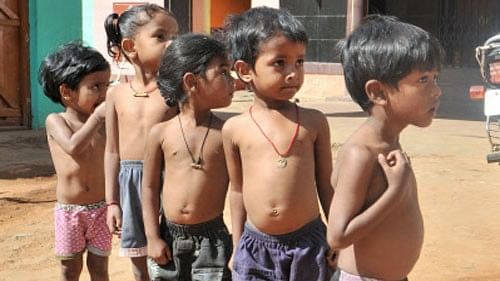
Representative image of malnourished children.
Credit: DH File Photo
India is expected to miss the 2030 deadline for achieving the Sustainable Development Goal (SDG) related to children’s health — lowering the rate of stunting and lowering under-five and infant mortality — according to the Goalkeepers 2024 research released by the Bill and Melinda Gates Foundation.
The public health narrative has traditionally focused on malnutrition, a significant concern. However, an emerging crisis is reshaping the region's health landscape: the dual burden of malnutrition and obesity. This paradox, where undernutrition coexists with rising obesity rates, threatens to undermine the region's social and economic progress.
India grapples with this stark health paradox: While 135 million citizens are obese and 9.3% of adults have diabetes costing the economy $8.7 billion annually, 38% of children under five remain stunted from chronic malnutrition. Both conditions stem from intertwined socio-economic factors and dietary patterns.
Conventional wisdom links malnutrition to poverty and obesity to wealth, but this oversimplifies the reality. Obesity increasingly affects low- and middle-income populations across both urban and rural landscapes, driven by calorie-dense yet nutrient-poor foods, and exacerbated by lifestyle shifts brought on by urbanisation, mechanisation, and sedentary work patterns.
Maternal malnutrition and poor childhood nutrition significantly increase the risk of obesity later in life, a phenomenon explained by the ‘thrifty phenotype hypothesis’, which posits that infants born underweight due to maternal malnutrition are more susceptible to obesity and metabolic disorders such as diabetes when exposed to high-calorie diets as adults.
In India and South Asia, dietary patterns skewing heavily towards carbohydrates while lacking essential nutrients create ‘hidden hunger’ — a form of malnutrition where caloric needs are met, but micronutrient deficiencies persist. This nutritional imbalance can predispose individuals to obesity, even in populations historically plagued by undernutrition.
The World Health Organization (WHO) reports an alarming surge in obesity rates across low- and middle-income countries, where processed foods laden with added sugars, salt, and unhealthy fats have rapidly displaced traditional diets. India, in particular, is grappling with the rise of ‘urban poverty diets’ — affordable and readily available that are calorie-rich but nutritionally poor. Across urban slums and rural areas, a significant portion of the population has become dependent on ultra-processed foods due to their affordability and aggressive marketing campaigns.
According to the National Health Mission (NHM, 2023), India faces a daunting public health challenge as it grapples with the dual faces of hunger: malnutrition and obesity. This strain forces governments to tackle both childhood undernutrition and rising non-communicable diseases (NCDs) such as diabetes and heart disease. The economic toll is staggering, with obesity-related deaths, healthcare costs, and reduced productivity threatening growth.
Policymakers must think beyond traditional strategies, incorporating human-centred designs, behavioural economics, and community-based participatory research (CBPR) to address malnutrition and obesity. It is crucial to understand the food-selection process of low-income families to design effective nudges towards healthier options, such as subsidies for fruits and vegetables or redesigning stores to highlight healthier options.
The complexity of this problem requires a system-thinking approach with the solution tying together different sectors such as agriculture, food production, health, and education. Governments should promote sustainable agriculture practices, ensuring that nutritious foods are affordable and accessible while addressing food security and poverty. Regular health impact assessments (HIA) are crucial to evaluate the long-term outcomes of various initiatives.
Solving this problem in India requires a nationwide approach. Schools should play an important role in promoting healthy eating and physical activity. Legislation can be introduced by governments to regulate the selling of junk food to minors and guarantee that nutritious food is served in schools. Public health initiatives modelled after successful programmes such as India's anti-tobacco campaigns can increase knowledge of the risks associated with obesity and encourage a healthy diet. Additionally, more work needs to be done in rural areas where illiteracy still affects millions of people and limits their access to wholesome food.
Human-centred design principles offer opportunities to tailor solutions to India’s diverse population. Engaging parents, teachers, and children in designing school meal programmes and physical activity initiatives ensures these solutions are practical, sustainable, and culturally relevant. Behavioural nudges — such as positioning healthier food options at eye level in school cafeterias or using clear, easy-to-understand labelling systems on packaged foods — could gently encourage children to make healthier choices without feeling restricted. Embracing and scaling innovations will also be critical in addressing this issue.
India must acknowledge the interconnectedness of malnutrition and obesity, recognising them as a single, and multifaceted crisis. Governments, international organisations, NGOs, private industries, healthcare providers, and communities must collaborate to develop sustainable solutions that address the full spectrum of nutritional needs. By investing in human-centred design, behavioural economics, community engagement, and systems thinking, India can build a healthier future. The time for action is now to prevent this dual burden from becoming an insurmountable public health crisis.
Pranjal Pandey is a Delhi-based journalist. Vijay Raju is co-founder, Obesity Innovation Lab, and former head of strategy, World Economic Forum Members.
Disclaimer: The views expressed here are the authors' own. They do not necessarily reflect the views of DH.